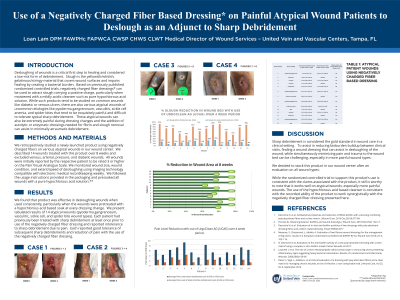Case Series/Study
(CS-078) Use of a Negatively Charged Fiber Based Dressing* on Painful Atypical Wound Patients to Deslough as an Adjunct to Sharp Debridement

Desloughing of wounds is a critical first step to healing and considered a low-risk form of debridement. Slough is the yellowish/whitish, gelatinous/stringy material that covers wound surfaces and impairs healing by creating a bacterial burden. Based on previously published randomized controlled trials, negatively charged fiber dressings* can be used to attract slough carrying a positive charge, particularly when moistened with a mildly acidic cleanser such as pure hypochlorous acid solution. While such products tend to be studied on common wounds like diabetic or venous ulcers, there are also various atypical wounds of uncommon etiologies like pyoderma gangrenosum, vasculitis, sickle cell anemia, and spider bites that tend to be exquisitely painful and difficult to tolerate typical sharp debridement.
Methods:
We retrospectively studied a newly launched product using negatively charged fibers on various atypical wounds in our wound center. We described 14 wounds treated with this product over 8 weeks and excluded venous, arterial, pressure, and diabetic wounds. All wounds were initially reported by the respective patient to be rated 3 or higher on the Pain Visual Analogue Scale. We monitored wound size, wound condition, and extent/speed of desloughing using imaging technology compatible with electronic medical recordkeeping. We followed the usage instructions provided in the packaging and presoaked all wounds with a pure hypochlorous acid solution.**
Results: We found that product was effective in desloughing wounds when used consistently, particularly when the wounds were pretreated with a hypochlorous acid based soak at every dressing change. We present tabulated results of 14 atypical wounds (pyoderma gangrenosum, vasculitic, sickle cell, and spider bite wound types). Each patient had previously been treated with sharp debridement at least once prior to use of the negatively charged fiber dressing and reported intolerance to sharp debridement due to pain. Each reported good tolerance of subsequent sharp debridements and reduction of pain with the use of the negatively charged fiber dressing.
Discussion: We decided to stock this product in our wound center after an evaluation on all wound types. While the randomized controlled trial to support this product's use is consistent with the claims associated with the product, it still is worthy to note that it works well on atypical wounds, especially more painful wounds. The use of the hypochlorous acid based cleanser is consistent with the recorded ability of the product to work synergistically with the negatively charged fiber dressing presented here.

.jpg)